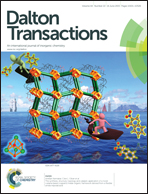Mixed ligand copper(ii) dicarboxylate complexes: the role of co-ligand hydrophobicity in DNA binding, double-strand DNA cleavage, protein binding and cytotoxicity†
Abstract
A few water soluble mixed ligand copper(II) complexes of the type [Cu(bimda)(diimine)] 1–5, where bimda is N-benzyliminodiacetic acid and diimine is 2,2′-bipyridine (bpy, 1) or 1,10-phenanthroline (phen, 2) or 5,6-dimethyl-1,10-phenanthroline (5,6-dmp, 3) or 3,4,7,8-tetramethyl-1,10-phenanthroline (3,4,7,8-tmp, 4) and dipyrido[3,2-d: 2′,3′-f]quinoxaline (dpq, 5), have been successfully isolated and characterized by elemental analysis and other spectral techniques. The coordination geometry around copper(II) in 2 is described as distorted square based pyramidal while that in 3 is described as square pyramidal. Absorption spectral titrations and competitive DNA binding studies reveal that the intrinsic DNA binding affinity of the complexes depends upon the diimine co-ligand, dpq (5) > 3,4,7,8-tmp (4) > 5,6-dmp (3) > phen (2) > bpy (1). The phen and dpq co-ligands are involved in the π-stacking interaction with DNA base pairs while the 3,4,7,8-tmp/5,6-dmp and bpy co-ligands are involved in respectively hydrophobic and surface mode of binding with DNA. The small enhancement in the relative viscosity of DNA upon binding to 1–5 supports the DNA binding modes proposed. Interestingly, 3 and 4 are selective in exhibiting a positive induced CD band (ICD) upon binding to DNA suggesting that they induce B to A conformational change. In contrast, 2 and 5 show CD responses which reveal their involvement in strong DNA binding. The complexes 2–4 are unique in displaying prominent double-strand DNA cleavage while 1 effects only single-strand DNA cleavage, and their ability to cleave DNA in the absence of an activator varies as 5 > 4 > 3 > 2 > 1. Also, all the complexes exhibit oxidative double-strand DNA cleavage activity in the presence of ascorbic acid, which varies as 5 > 4 > 3 > 2 > 1. The ability of the complexes to bind and cleave the protein BSA varies in the order 4 > 3 > 5 > 2 > 1. Interestingly, 3 and 4 cleave the protein non-specifically in the presence of H2O2 as an activator suggesting that they can act also as chemical proteases. It is remarkable that 2–5 exhibit cytotoxicity against human breast cancer cell lines (MCF-7) with potency higher than the widely used drug cisplatin indicating that they have the potential to act as effective anticancer drugs in a time dependent manner. The morphological assessment data obtained by using Hoechst 33258 staining reveal that 3 and 4 induce apoptosis much more effectively than other complexes. Also, the alkaline single-cell gel electrophoresis study (comet assay) suggests that the same complexes induce DNA fragmentation more efficiently than others.


 Please wait while we load your content...
Please wait while we load your content...